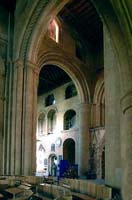| |
 |
Southwell Southwell Cathedral |
The church, often known as Southwell Minster, was founded in the mid 10th century with an accompanying college of priests. Construction of the present building began in 1108 at the behest of the Archbishop of York, in whose diocese Southwell Minster lay until the church acquired cathedral status in 1884.
The Norman east end was demolished in 1234 and is only known from excavation. It was unusual for its period in having a chancel with a straight end instead of an apse, although the chancel aisles ended in apses. The Norman transepts survive and each had an apse projecting to the east. The early 12th century capitals of the eastern piers of the crossing have each been carved with a Biblical scene as if to emphasise the junction with the chancel to its east. In art historical terms these capitals are considered to be amongst the most important of their date in England
Above the apexes of the main roofs the Norman tower is lavishly decorated with blank arcading suggesting it was built in two stages as the lower part is plain. The nave is of eight bays; the westernmost being below twin towers. They have the characteristic flat corner buttresses of the period, but are unique in England in having pyramidal roofs which, although rebuilt, give a good impression of how towers were normally finished off in Norman churches. Norman also is the north porch with an unusual tunnel vault and an upper chamber.
In the north transept there is an early 12th century lintel, not in its original position, carved with St Michael and the dragon, and David rescuing his flock from the lion.
BibliographyDixon, P., 1989. 'Southwell Minster', in Royal Archaeological Institute, Proceedings of the 135th Summer Meeting, supplement to Archaeological Journal 146, 21 - 3
Dixon, P., Owen, O. and Stocker, D., 2001. 'The Southwall lintel, its style and significance', in J. Graham-Campbell, R. Hall, J. Jesch and D.N. Parsons, Vikings and the Danelaw (Oxford), 245-68
Pevsner, N., 1979. The Buildings of England, Nottinghamshire (London, Penguin, 2nd ed., revised by E. Williamson). 318 - 29